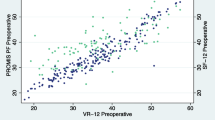Abstract
The Roland Morris Disability Questionnaire (RMDQ-24) and the VAS spine score have been regularly used to measure functional outcome in patients with back pain. The RMDQ-24 is primarily used in degenerative disease of the spine and the VAS Spine is used in trauma patients. The aim of this study is to compare these scores and to see if there is a correlation in patients with a traumatic thoracolumbar spinal fracture. Prospective cohort study comparing the RMDQ-24 and the VAS spine score in patients with a traumatic type A fracture thoracolumbar spine fracture. Fifteen non-operatively patients (group one) completed 118 questionnaires and 17 operatively treated patients (group two) completed 140 questionnaires. Group one scored an average of 6.6 and 65.9 for the RMDQ-24 and VAS Spine, in group two this was 5.1 and 82.9. Spearman’s correlation test showed a significant correlation, in group one 0.83 and for the second group 0.87. RMDQ-24 and VAS Spine have a strong positive correlation in measuring disability in a group of patients with back pain because of a spinal fracture. In both non-operatively and operatively treated groups this correlation is significant.


Similar content being viewed by others
References
Denis F, Armstrong GW, Searls K, Matta L (1984) Acute thoracolumbar burst fractures in the absence of neurologic deficit. A comparison between operative and nonoperative treatment. Clin Orthop Relat Res (189):142–149
Grotle M, Brox JI, Vollestad NK (2004) Concurrent comparison of responsiveness in pain and functional status measurements used for patients with low back pain. Spine 29(21):E492–E501. doi:10.1097/01.brs.0000143664.02702.0b
Jordan K, Dunn KM, Lewis M, Croft P (2006) A minimal clinically important difference was derived for the Roland–Morris Disability Questionnaire for low back pain. J Clin Epidemiol 59(1):45–52. doi:10.1016/j.jclinepi.2005.03.018
Knop C, Blauth M, Bastian L, Lange U, Kesting J, Tscherne H (1997) Fractures of the thoracolumbar spine. Late results of dorsal instrumentation and its consequences. Unfallchirurg 100(8):630–639. Frakturen der thorakolumbalen Wirbelsaule. Spatergebnisse nach dorsaler Instrumentierung und ihre Konsequenzen. doi:10.1007/s001130050168
Knop C, Oeser M, Bastian L, Lange U, Zdichavsky M, Blauth M (2001) Development and validation of the visual analogue scale (VAS) spine score. Unfallchirurg 104(6):488–497. Entwicklung und Validierung des VAS-Wirbelsaulenscores. doi:10.1007/s001130170111
Kraemer WJ, Schemitsch EH, Lever J, McBroom RJ, McKee MD, Waddell JP (1996) Functional outcome of thoracolumbar burst fractures without neurological deficit. J Orthop Trauma 10(8):541–544. doi:10.1097/00005131-199611000-00006
Leclaire R, Blier F, Fortin L, Proulx R (1997) A cross-sectional study comparing the Oswestry and Roland–Morris Functional Disability scales in two populations of patients with low back pain of different levels of severity. Spine 22(1):68–71. doi:10.1097/00007632-199701010-00011
Leferink VJM, Keizer HJE, Oosterhuis JK, Sluis CK van der, Duis HJ ten (2003) Functional outcome in patients with thoracolumbar burst fractures treated with dorsal instrumentation and transpedicular cancellous bone grafting. Eur Spine J 12(3):261–267
Magerl F, Aebi M, Gertzbein SD, Harms J, Nazarian S (1994) A comprehensive classification of thoracic and lumbar injuries. Eur Spine J 3(4):184–201. doi:10.1007/BF02221591
Ohnhaus EE, Adler R (1975) Methodological problems in the measurement of pain: a comparison between the verbal rating scale and the visual analogue scale. Pain 1(4):379–384. doi:10.1016/0304-3959(75)90075-5
Post RB, Keizer HJ, Leferink VJ, van der Sluis CK (2006) Functional outcome 5 years after non-operative treatment of type A spinal fractures. Eur Spine J 15(4):472–478. doi:10.1007/s00586-005-0887-5
Resch H, Rabl M, Klampfer H, Ritter E, Povacz P (2000) Surgical vs. conservative treatment of fractures of the thoracolumbar transition Unfallchirurg 103(4):281–288. Operative vs. konservative Behandlung von Frakturen des thorakolumbalen Ubergangs. doi:10.1007/s001130050537
Revill SI, Robinson JO, Rosen M, Hogg MI (1976) The reliability of a linear analogue for evaluating pain. Anaesthesia 31(9):1191–1198. doi:10.1111/j.1365-2044.1976.tb11971.x
Roland M, Morris R (1983) A study of the natural history of low-back pain. Part II: development of guidelines for trials of treatment in primary care. Spine 8(2):145–150. doi:10.1097/00007632-198303000-00005
Scott J, Huskisson EC (1976) Graphic representation of pain. Pain 2(2):175–184. doi:10.1016/0304-3959(76)90113-5
Shen WJ, Liu TJ, Shen YS (2001) Nonoperative treatment versus posterior fixation for thoracolumbar junction burst fractures without neurologic deficit. Spine 26(9):1038–1045. doi:10.1097/00007632-200105010-00010
Waddell G, Main CJ (1984) Assessment of severity in low-back disorders. Spine 9(2):204–208. doi:10.1097/00007632-198403000-00012
Weinstein JN, Collalto P, Lehmann TR (1988) Thoracolumbar “burst” fractures treated conservatively: a long-term follow-up. Spine 13(1):33–38. doi:10.1097/00007632-198801000-00008
Wiesinger GF, Nuhr M, Quittan M, Ebenbichler G, Wolfl G, Fialka-Moser V (1999) Cross-cultural adaptation of the Roland–Morris questionnaire for German-speaking patients with low back pain. Spine 24(11):1099–1103. doi:10.1097/00007632-199906010-00009
Wood K, Butterman G, Mehbod A, Garvey T, Jhanjee R, Sechriest V (2003) Operative compared with nonoperative treatment of a thoracolumbar burst fracture without neurological deficit. A prospective, randomized study. J Bone Joint Surg Am 85-A(5):773–781
Zerbini C, Ozturk ZE, Grifka J, Maini M, Nilganuwong S, Morales R et al (2005) Efficacy of etoricoxib 60 mg/day and diclofenac 150 mg/day in reduction of pain and disability in patients with chronic low back pain: results of a 4-week, multinational, randomized, double-blind study. Curr Med Res Opin 21(12):2037–2049. doi:10.1185/030079905X75069
Author information
Authors and Affiliations
Corresponding author
Additional information
No funds were received in support of this work. No benefits in any form have been or will be received from a commercial party related directly or indirectly to the subject of this manuscript.
Rights and permissions
About this article
Cite this article
Siebenga, J., Leferink, V.J.M., Segers, M.J.M. et al. A prospective cohort study comparing the VAS spine score and Roland–Morris disability questionnaire in patients with a type A traumatic thoracolumbar spinal fracture. Eur Spine J 17, 1096–1100 (2008). https://doi.org/10.1007/s00586-008-0705-y
Received:
Revised:
Accepted:
Published:
Issue Date:
DOI: https://doi.org/10.1007/s00586-008-0705-y




